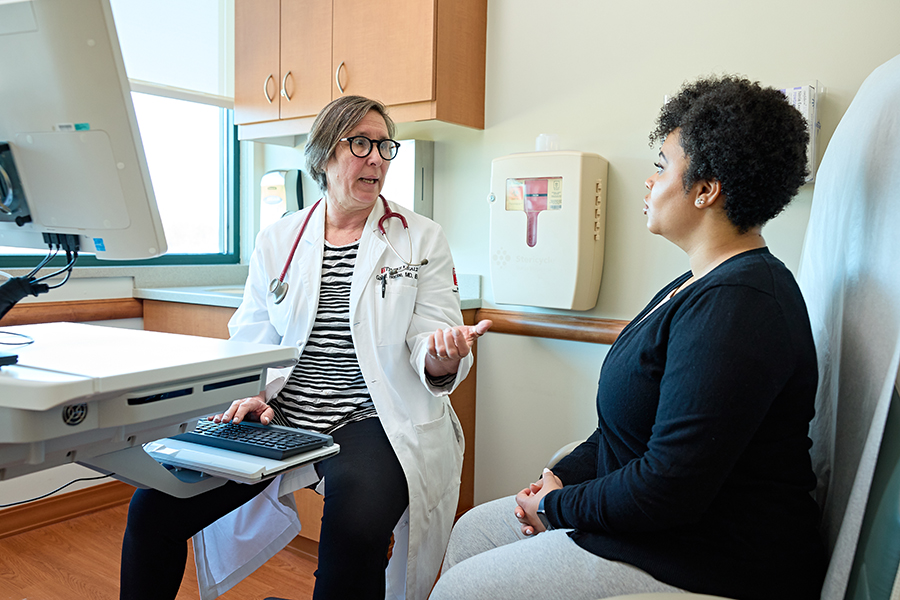From a Better Birth Experience to Earlier Bonding, Birth Planning Has Extensive Benefits–and Improved Outcomes

As the digital age advances, data has become increasingly vital for decision-making and identifying ways to improve results. That’s critical in healthcare, especially, where even small details, probabilities, and assumptions can make a big difference in patients’ outcomes. But to utilize data successfully, we need to be able to spot how our own biases and even simple mistakes can shape the data, how it’s used, and how it impacts people. If applied algorithmically at a large scale, a minor misinterpretation can have a profound impact–and a small change can save countless lives.
The impact can be clearly seen when it comes to issues of inequity and at-risk populations in pregnancy care. On a national level, the maternal mortality rate among Black women is 2.6 times higher than the rate for white women. This inequity carries when you zoom in on different conditions and birth interventions. For example, people of color have historically been shown to be less likely to be diagnosed with anemia during pregnancy. They are also less likely to receive epidurals, which are critical to pain management in pregnant people. According to Dr. John Kissko, anesthesiologist at Temple Health, research indicates that this is in part due to applications of data that are now seen as outmoded.
That’s why the work of physicians like Kissko promises to have such a profound impact. As the Site Chief of Anesthesia for the new Women & Families Campus, his work at Temple Health is helping to overcome challenges stemming from social determinants of health and limitations in data that have historically contributed to disparities in pregnancy care within healthcare.
“We know these disparities exist, and so we try to break through the barriers on an individual patient basis day-to-day, but also by mass education and dissemination of accurate, up-to-date information,” Kissko says.
Kissko has found a way to advance equity in pregnancy care head-on with research-informed decision-making protocols and outreach that have made Temple Health a unique source of support for populations that face statistically higher risk in pregnancy care. Kissko is now looking to share those innovations with other hospitals–which could improve pregnancy outcomes for people at risk across the region.

“The clinic makes a big difference in patient outcomes by allowing us to see patients early in pregnancy and teach them why their labor analgesia choice is important for both them and their babies,” Kissko says.
Data-Driven Decisions
It’s important to understand that data-driven guidelines, when used properly, can be a significant aid for decision-making.
“Calculators, protocols, pathways, and guidelines are all examples of aids for practitioners (and in some cases patients) that help boil down a large amount of data into an accessible, easy to use, and (hopefully) easy to understand format,” Kissko says. “They are supposed to incorporate and summarize the best available data to improve patient outcomes and streamline care.”
However, it’s critical to keep them updated with the latest research–and to consider each case on its own merits. “These things are only as good as the data that goes into them,” Kissko says. “These guides (and guides in general) can absolutely be used effectively in some situations. Clinicians have to look at any of the guides they use critically and assess not only whether they are accurate and up to date but also apply them to the patient they have in front of them.”
Even when treating each patient individually, keeping those protocols current can be an important aid–especially for healthcare providers who are less able to pursue their research and depend more on protocols from organizations like Temple Health to guide their approach. That’s why physicians perform active research at academic medical centers like Temple to stay at the forefront of leading treatments and approaches. Kissko is no exception. “As with anything, things change,” Kissko says. “This is most important to recognize so we can continue to pivot and change to provide the highest quality care to our patients.”
Re-Examining the Numbers
As Kissko notes, a matter of research policy can, therefore, make a big difference in treatment decisions across different healthcare providers. In the case of anemia, for example, historically, racial identity was thought to influence patients’ blood composition. This resulted in protocols that stated that lower levels of hemoglobin in a patient’s blood could indicate a diagnosis of anemia in a patient of one race, while the same levels of hemoglobin could be considered safe in a different patient. Black patients, in particular, received fewer diagnoses of anemia as a result, creating a concerning disparity in treatment decisions–and, ultimately, outcomes.
“[Some patients] were not being treated for their anemia because they were not defined as anemic,” Kissko says. A similar challenge has historically been present in determining whether to encourage vaginal birth after an earlier c-section (VBAC) or to recommend another c-section.
“One of the factors in the original VBAC calculator was race, and it ended up predicting that patients who were non-white were going to have a lower success rate at having a vaginal birth after c-section,” Kissko says.
Another illustration of some birthing differences among populations is epidural use, for which population-wide differences are well-defined in the data. “Black and Hispanic patients have historically [received fewer overall] epidurals for labor analgesia,” Kissko says. “This has been in medical literature for years.”
Since these algorithms were put in place, the medical community has evolved in its understanding of the role that social constructs play in race, which makes it a less informative data point in cases such as anemia. Temple Health does not use race-based data in their protocols for anemia or vaginal births after c-sections, for example, though race-based criteria are still utilized at some centers, even today.
“The definition of race is now understood as a social construct, not a biologically based concept when it comes to medical decision making,” Kissko says.
Experts in the space point to these concepts being applied to patient care as one factor behind the disparity in pregnancy outcomes. According to March of Dimes, a major nonprofit dedicated to maternal and infant health, work like Kissko’s in helping more hospitals move on from these policies should be a priority.
“March of Dimes acknowledges the importance of ensuring that pregnancy care is free from race-based factors that perpetuate inequitable health outcomes for all individuals,” says Allison Lang, senior executive director at March of Dimes. “We advocate for the careful examination of practices and policies within the [health care space] to eliminate any biases that may exist and to ensure that care is based on medical evidence and individual needs rather than demographic factors.”
By recommending to hospitals that they forgo those assumptions and the calculations built around them in favor of more individualized diagnoses, Kissko hopes to ensure care is effectively delivered to those who need it.

Kissko works to provide educational materials to patients to empower informed decisions about pain management ahead of the excitement and stress of labor.
Going Beyond the Protocols
The path to more equitable care through data also requires another step: outreach. Kissko notes that today’s research-informed protocols have equalized the populations considered for epidural use, but systemic disparities still prevent equitable utilization. The problem isn’t just in an algorithm but a collection of factors related to social determinants of health, including a lack of sufficient, accurate patient education. And data can help Kissko reach those populations.
“Some patients are getting information that is not entirely accurate–from friends, family, and sometimes, their other health providers. Anesthesiologists, who have the knowledge, generally don’t see patients until they come in to deliver,” Kissko says, noting the impossibility of dispelling fears that epidurals may cause paralysis or chronic back pain during labor.
Kissko wants to bridge that gap. One solution is to include anesthesiologists, or at least information provided by them, as part of childbirth education classes and other healthcare appointments before birth. The goal is for birthing people to have their concerns recognized and addressed directly, with time to process ahead of the stress and excitement of labor. Increased one-on-one face time also helps facilitate individualized diagnoses and treatment, which has led Kissko to create a high-risk OB anesthesia clinic. The clinic allows Kissko to deliver additional support to those who need it most.
“The clinic makes a big difference in patient outcomes by allowing us to see patients early in pregnancy and teach them why their labor analgesia choice is important for both them and their babies,” Kissko says.
Digital communication can also be used to get information directly to communities where they interact online, a project Kissko is currently working on. The aim, he says, is “overcoming [barriers] from all different sides with all different media, and all different types of educational materials.” These resources are created in multiple languages and formats to make the content accessible to all groups.
Altogether, these approaches, while not requiring some breakthrough discovery or complex invention, can make just as much of a difference in people’s lives–and are critical in an age where the use of data and navigating barriers to care can make all the difference.
“When addressing unequal pregnancy care, March of Dimes considers a range of factors, including epidural use, anemia, and the option for vaginal delivery. These issues are of significant importance as they can impact maternal and infant health outcomes,” Lang says.
Helping the Region
The importance of this issue drives Kissko to collaborate with other healthcare providers to pool resources and thereby change policy and find nuanced, on-the-ground solutions. Kissko is currently bringing his expertise, along with a couple of fellow Temple physicians, to a regional coalition of care providers to reexamine how hospitals in the area use data and policy to make clinical decisions and influence public health. The aim is to help other providers determine how to overcome the data-driven and communication barriers that have, in part, led to disparities in how people of color receive pregnancy care.
In the next year, the coalition aims to roll out a plan that recommends forgoing or replacing old algorithms that guide decision-making and instituting new decision-making protocols and outreach that could help overcome the historic lack of support some populations face in pregnancy care. Kissko hopes that the changes to policy and analysis will have a big impact–improving pregnancy outcomes for people of color across the region, even if the patients may not realize how big a change is being made.
“No one’s going to pick a place based on anesthesia,” Kissko says. “But they should know that the resources are there.”
This is a paid partnership between Temple Health and Philadelphia Magazine